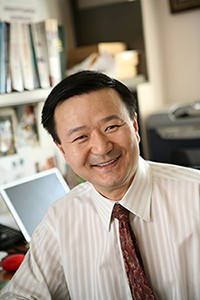In an orchestra, each instrument plays an important role in creating a beautiful piece of music. If just one instrument falls out of rhythm, a world-class symphony could sound more like a middle-school orchestra practice.

Similarly, the heart is controlled by a complex system of electrical signals. If any of the signals fail, the results can be fatal.Proteins called ion channels generate the electrical signals of the heart by opening a gate or pore for charged ions to cross the cell membrane. If the ion channels are the musicians of the orchestra, the membrane voltage is the conductor. That is, the membrane voltage signals to the channels the proper time to open and keeps them all in rhythm.
For decades, scientists assumed that the membrane voltage determines when the ion channels open, but does not affect the qualities of the electrical signals from the open channels.
However, a team of biomedical engineers in the School of Engineering & Applied Science at Washington University in St. Louis has discovered that for one important channel in the heart, called KCNQ1, the membrane voltage not only causes the channel to open, but also determines the properties of the electrical signals, acting as both conductor and composer rather than only conductor as previously believed.
Jianmin Cui, PhD, a professor of biomedical engineering, and Mark Zaydman, a fifth-year MD/PhD student, and their team study the fundamental mechanisms of how ion channels sense membrane voltage and respond by opening the pore.
The potassium channel that they focused on, KCNQ1, is so important to the heart’s rhythm that there are more than 250 mutations of the channel that have been associated with cardiac arrhythmia, Cui said.
“The trouble was that without an accurate model of how the channel gating works, we were limited in our understanding of why these mutations lead to fatal arrhythmias and in our ability to design therapeutic interventions that can specifically fix the defect in the afflicted tissues,” he said.
“This knowledge we’re providing is to revise the story that was the model built in the 1950s,” Cui said.
“Based on the fundamental understanding that we’ve gained with our research, we’ve devised a novel model of voltage-dependent gating that is both more accurate and more physically intuitive than all previous models,” Zaydman said. “We have already shown its utility by answering this long-standing question with KCNE1.”
In the heart, KCNQ1 works with another protein called KCNE1, an accessory subunit. When the two are put together, the combination changes the properties of the KCNQ1 channel so dramatically that scientists were once misled to believe that KCNE1 formed an entirely new channel on its own, rather than modifying an existing one, Zaydman said.
“The properties of the KCNQ1 channel are only right for its role in the heart when it is associated with the KCNE1 subunit,” he said. “The mechanism by which KCNE1 affects KCNQ1 has been debated for 18 years without a satisfactory resolution. We were finally able to provide a complete mechanism. This would not have been possible without the knowledge gained by our experimental work and represented in our mathematical model.”
Zaydman says if physicians want to treat patients with arrhythmia, they need to be able to target the channels in the heart without affecting the same channels in the gut, the thyroid or the brain.
“So for targeted drug therapy, it’s important to understand what is different about the channel in the heart where you have this one accessory subunit,” he said. “Now we have a rationale for how to target the electrical signals in the heart without causing adverse effects in the other tissues.”
Because this work is so fundamental, its application may extend beyond this particular channel, Cui said.
“This model has the potential to aid researchers in the study of all voltage-gated ion channels and their associated diseases,” he said.
Funding for this research was provided by the National Institutes of Health (R01-HL70393 and R01-NS060706), National Science Foundation of China and the Major International Joint Research Program Fund of China.
###
The School of Engineering & Applied Science at Washington University in St. Louis focuses intellectual efforts through a new convergence paradigm and builds on strengths, particularly as applied to medicine and health, energy and environment, entrepreneurship and security. With 91 tenured/tenure-track and 40 additional full-time faculty, 1,300 undergraduate students, more than 900 graduate students and more than 23,000 alumni, we are working to leverage our partnerships with academic and industry partners — across disciplines and across the world — to contribute to solving the greatest global challenges of the 21st century.
Zaydman M, Kasimova M, McFarland K, Beller Z, Hou P, Kinser H, Liang H, Zhang G, Shi J, Tarek M, and Cui J. “Domain-domain interactions determine the gating, permeation, pharmacology, and submit modulation of the IKs ion channel.” eLife, Dec. 23, 2014. http://dx.doi.org/10.7554/eLife.03606